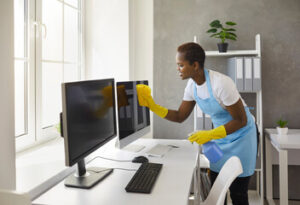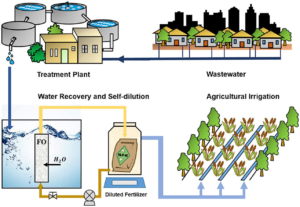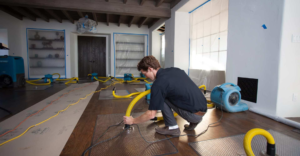Commercial Cleaning Services Baltimore provide a variety of tasks, including trash removal, floor care, and disinfection. They also offer specialized services for industries that require specific hygiene regulations, like medical offices or food processing facilities.

Business owners often hire a professional cleaner because it makes more sense than asking their staff to do the cleaning along with their regular jobs. Professional cleaners have the equipment and training to ensure a clean space that will impress clients and customers.
Today’s customers want and expect clean commercial environments, so keeping your business’ spaces tidy is a great way to build your reputation, impress your clients, and maintain high operational efficiency. However, it’s a huge job that can be difficult to accomplish without the help of professional commercial cleaning services.
A company that specializes in commercial cleaning services will have a team of trained and experienced professionals, equipment, and chemicals that are specially designed for commercial spaces. These cleaners can sanitize and disinfect any area, including those hard-to-reach spots that can harbor harmful pathogens like bacteria and viruses.
Commercial spaces often have much higher foot traffic than residential places, so they require more rigorous and consistent sanitization to prevent the spread of germs and illnesses. This includes areas like restaurants, retail stores, healthcare and fitness facilities, financial and banking establishments, and any other place that serves the public or businesses.
The scope of work for a commercial cleaning service can include anything from basic cleaning and organization to more comprehensive sanitation, disinfection, and maintenance. They may also offer specialty cleaning services for industries like food, healthcare, and hospitality. They will usually provide a consultation with the client and ask for any specific requests or special circumstances that should be taken into account when creating a cleaning schedule.
A commercial cleaning service will often have many cleaners, which allows them to take care of regular cleaning tasks even during holiday periods or if staff become sick. They can also provide regular reports and inspections that show the status of sanitization and cleanliness throughout the facility.
When choosing a commercial cleaning service, it’s important to choose one that has a good track record and is licensed and insured. You should also make sure the cleaning services are suitable for your type of business and budget. It’s also a good idea to get references from previous clients and compare quotes from multiple companies before making a decision. Once you’ve found the right cleaning service, they will be able to handle all your regular cleaning needs and keep your business looking its best.
Carpet and Upholstery Cleaning
Commercial cleaning services can help keep a business looking and smelling clean. They can offer a wide range of services, including regular vacuuming and mopping, cleaning windows, emptying trash bins, and sanitizing bathrooms. They can also provide specialized services, such as deep carpet cleaning or floor stripping and waxing. They can also help businesses maintain compliance with industry regulations by cleaning and disinfecting equipment and sanitizing common areas.
While janitorial cleaning services can be helpful in any business, they’re especially vital for public-facing businesses like retail stores, restaurants, and offices. These types of spaces are often heavily trafficked by customers and clients, making them a perfect place for germs to spread. Cleaning and sanitizing these spaces regularly helps reduce the risk of illness, as well as create a more professional image for companies.
Carpets and upholstery are an essential part of any workplace, but they can get soiled and stained quickly in busy spaces. Commercial cleaners use a variety of methods to clean upholstered furniture, including steam cleaning and hot water extraction. They can also use stain removal treatments to remove stubborn stains and discoloration. They can also keep upholstery clean and healthy by removing allergens, which can improve indoor air quality and reduce the risk of respiratory issues for employees and visitors.
A good commercial cleaning service will have the necessary experience and training to handle any type of environment. They should also be licensed and insured to work in the space they’re cleaning. When choosing a company, it’s important to ask for references and compare pricing structures. Businesses like Cleantex provide pickup and delivery options, which can be very convenient for some businesses. Bridges explains that she uses the service because they give her tight time windows for pickup and delivery and even allow her to track the driver online.
Another great thing about commercial cleaning is that it’s tailored to the specific needs of each business. Different industries have unique standards that need to be met in order for the business to stay compliant. Medical facilities, for example, must abide by strict cleaning and disinfecting standards in order to prevent the spread of disease. Using a commercial cleaning company that has experience working in these types of environments can ensure that the business stays in compliance and provides a safe and healthy workplace for its employees and customers.
Floor Care
Commercial cleaning services can clean and sanitize many types of flooring. They can strip and wax linoleum or vinyl floors, buff and burnish tile, and polish hardwood floors to make them shine. They can also remove scuff marks and provide protective coatings to help floors stay looking new. These services are important for a variety of reasons.
Carpets trap a lot of dust and dirt that can trigger respiratory problems in employees and customers. Regularly shampooing and steam cleaning carpets eliminates these particles and helps keep them healthy. Cleaning for health and wellness is becoming more and more important in the business world, especially as companies adopt WELL Building standards and seek to improve indoor air quality.
Regular sweeping and vacuuming help minimize fine abrasive grit that can damage floor surfaces over time. Mopping and scrubbing floors with conventional or microfiber wet and dry mops also keeps them looking their best. It can help extend the life of a floor, saving businesses money on replacement.
Depending on an establishment’s traffic and industry, a dirty floor can send a negative message about the business. Customers may assume that a business is disorganized or that they’ll have a difficult time finding something. A clean and sanitized environment can boost customer satisfaction, leading to more repeat business and referrals.
In addition to cleaning and sanitizing floors, commercial cleaners can clean windows, glass tables and other surfaces in offices and businesses. They can even remove stains from storefront window displays and doors. It is important to choose a cleaning company with experience and expertise in the type of floors and surface materials in an establishment.
Whether it is a corporate office, hospital, school, or other business, every business needs a professional appearance. A clean, sanitized space makes for a positive impression on customers and clients and can lead to increased revenue and profitability. It is essential to hire a cleaning company that offers the services you need and can offer competitive pricing. Request detailed quotes and compare pricing structures before choosing a cleaning service. It’s also a good idea to find out how a company hires its cleaners, as this can affect the level of skill and expertise they bring to their work.
Maintenance
Often, commercial cleaning services will also provide maintenance services for their clients. This includes dusting equipment, technology, and other items on a regular basis. Some companies may even offer landscape management or pest control. These services are important for maintaining the appearance of a business, especially in an industry that is known to attract pests and rodents.
A company that provides maintenance services may begin their work after a business has closed for the day. This means that their employees can perform the tasks without interrupting employees in their workspaces. They can also do their work without affecting productivity. Additionally, it is important to find out if a commercial cleaning service offers this option because it can save businesses time and money in the long run.
One of the most popular services that commercial cleaning companies provide is janitorial services. This is a form of daily cleaning that can include sweeping and vacuuming floors, disinfecting restrooms, and taking out the trash. These services can be very important for businesses, as a dirty work environment can affect employee morale and hurt the reputation of a company.
It is important to choose a reputable and experienced commercial cleaning service when choosing the right service for your business. The best way to do this is by asking for references and researching the different options that are available. Once you have gathered this information, it is important to choose the service that will meet your needs and budget.
In today’s post-COVID world, businesses are recognizing the importance of having both regular maintenance and deep cleaning services for their facilities. It is no longer enough to simply clean up for appearances; it is necessary to sanitize high-touch areas and do deep cleaning regularly to prevent the spread of germs and disease.
With the help of commercial cleaning services, businesses can rest assured knowing that their offices and other areas are sanitized properly and regularly. This helps to protect the health and safety of employees, customers, and potential clients. While some may think that they can handle these tasks in-house, it is typically much more cost effective to use a professional service to do the work for them.

